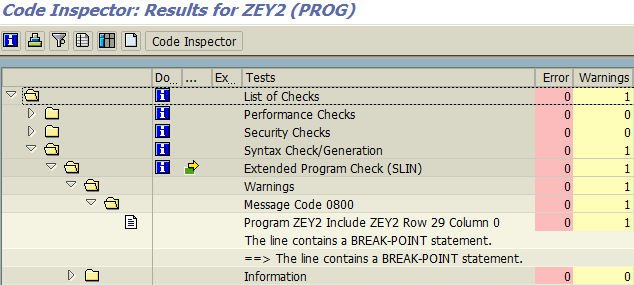SAP Code Inspector for ABAP Break-Point Statement
SAP Code Inspector displays Break-Point or Break ABAP statements in Extended Program Check (SLIN) but if developer wants to remain the code, he can use pseudo comment or pragmas. Using pragmas or pseudo comments after ABAP commands will enable SAP Code Inspector to ignore the related code as an error or warning.
As an ABAP programmer especially in development environment I frequently use Break or Break-Point commands. But it is wise to clear them before transporting to productive SAP systems.
ABAP developer can execute Code Inspector for their programs when they are within the ABAP program in SE38 ABAP Editor transaction by following the menu options:
Program > Check > Code Inspector
If ABAP programmer has used BREAK or BREAK-POINT statement within his/her ABAP codes, following warning message will be listed as a result of the SAP Code Inspector tool.
Syntax Check/Generation
Extended Program Check (SLIN)
Warnings
The line contains a BREAK-POINT statement.

If this BREAK or BREAK-POINT statement is necessary and the ABAP programmer does not want to comment or remove this statement, SAP Code Inspector tool can be informed about this decision. To correct this warning reporting about Break-Point command and enabling SAP Code Inspector to ignore this line can be managed by using Pseudo comments or Pragmas.
For example, instead of using the first ABAP code using the later code will prevent Code Inspector to report this as a warning or error.
* below code statement is reported in SAP Code Inspector
break kodyaz.
* following ABAP statement is ignored by Code Inspector
break kodyaz. "#EC NOBREAK
For a full list of Pragmas for Extended Program Checks ABAP developers can execute ABAP program ABAP_SLIN_PRAGMAS using SE38 transaction and display additional pragmas.
